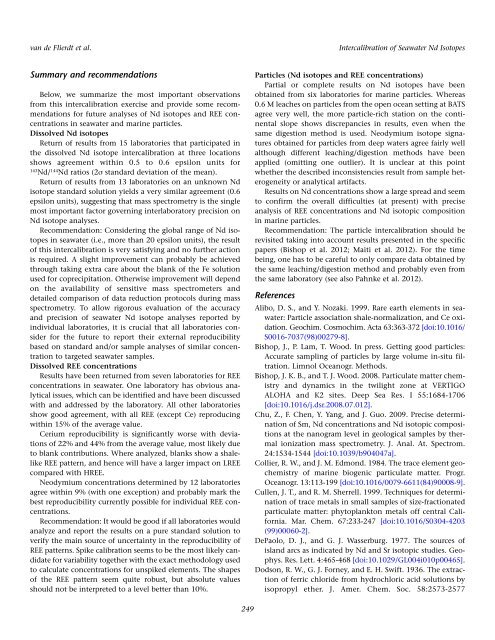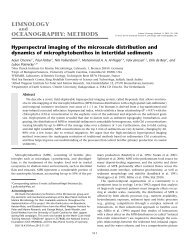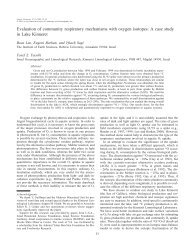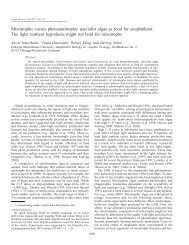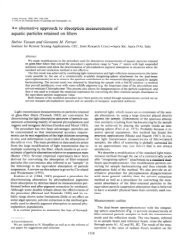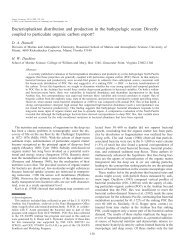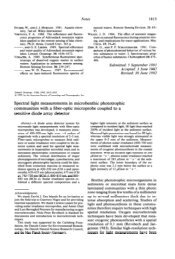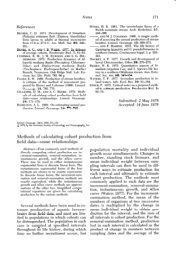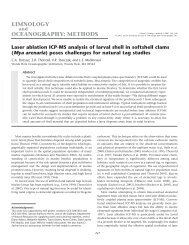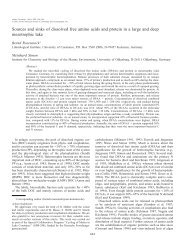Tina van de Flierdt, Katharina Pahnke, and GEOTRACES ... - ASLO
Tina van de Flierdt, Katharina Pahnke, and GEOTRACES ... - ASLO
Tina van de Flierdt, Katharina Pahnke, and GEOTRACES ... - ASLO
Create successful ePaper yourself
Turn your PDF publications into a flip-book with our unique Google optimized e-Paper software.
<strong>van</strong> <strong>de</strong> <strong>Flierdt</strong> et al. Intercalibration of Seawater Nd Isotopes<br />
Summary <strong>and</strong> recommendations<br />
Below, we summarize the most important observations<br />
from this intercalibration exercise <strong>and</strong> provi<strong>de</strong> some recommendations<br />
for future analyses of Nd isotopes <strong>and</strong> REE concentrations<br />
in seawater <strong>and</strong> marine particles.<br />
Dissolved Nd isotopes<br />
Return of results from 15 laboratories that participated in<br />
the dissolved Nd isotope intercalibration at three locations<br />
shows agreement within 0.5 to 0.6 epsilon units for<br />
143 Nd/ 144 Nd ratios (2s st<strong>and</strong>ard <strong>de</strong>viation of the mean).<br />
Return of results from 13 laboratories on an unknown Nd<br />
isotope st<strong>and</strong>ard solution yields a very similar agreement (0.6<br />
epsilon units), suggesting that mass spectrometry is the single<br />
most important factor governing interlaboratory precision on<br />
Nd isotope analyses.<br />
Recommendation: Consi<strong>de</strong>ring the global range of Nd isotopes<br />
in seawater (i.e., more than 20 epsilon units), the result<br />
of this intercalibration is very satisfying <strong>and</strong> no further action<br />
is required. A slight improvement can probably be achieved<br />
through taking extra care about the blank of the Fe solution<br />
used for coprecipitation. Otherwise improvement will <strong>de</strong>pend<br />
on the availability of sensitive mass spectrometers <strong>and</strong><br />
<strong>de</strong>tailed comparison of data reduction protocols during mass<br />
spectrometry. To allow rigorous evaluation of the accuracy<br />
<strong>and</strong> precision of seawater Nd isotope analyses reported by<br />
individual laboratories, it is crucial that all laboratories consi<strong>de</strong>r<br />
for the future to report their external reproducibility<br />
based on st<strong>and</strong>ard <strong>and</strong>/or sample analyses of similar concentration<br />
to targeted seawater samples.<br />
Dissolved REE concentrations<br />
Results have been returned from seven laboratories for REE<br />
concentrations in seawater. One laboratory has obvious analytical<br />
issues, which can be i<strong>de</strong>ntified <strong>and</strong> have been discussed<br />
with <strong>and</strong> addressed by the laboratory. All other laboratories<br />
show good agreement, with all REE (except Ce) reproducing<br />
within 15% of the average value.<br />
Cerium reproducibility is significantly worse with <strong>de</strong>viations<br />
of 22% <strong>and</strong> 44% from the average value, most likely due<br />
to blank contributions. Where analyzed, blanks show a shalelike<br />
REE pattern, <strong>and</strong> hence will have a larger impact on LREE<br />
compared with HREE.<br />
Neodymium concentrations <strong>de</strong>termined by 12 laboratories<br />
agree within 9% (with one exception) <strong>and</strong> probably mark the<br />
best reproducibility currently possible for individual REE concentrations.<br />
Recommendation: It would be good if all laboratories would<br />
analyze <strong>and</strong> report the results on a pure st<strong>and</strong>ard solution to<br />
verify the main source of uncertainty in the reproducibility of<br />
REE patterns. Spike calibration seems to be the most likely c<strong>and</strong>idate<br />
for variability together with the exact methodology used<br />
to calculate concentrations for unspiked elements. The shapes<br />
of the REE pattern seem quite robust, but absolute values<br />
should not be interpreted to a level better than 10%.<br />
249<br />
Particles (Nd isotopes <strong>and</strong> REE concentrations)<br />
Partial or complete results on Nd isotopes have been<br />
obtained from six laboratories for marine particles. Whereas<br />
0.6 M leaches on particles from the open ocean setting at BATS<br />
agree very well, the more particle-rich station on the continental<br />
slope shows discrepancies in results, even when the<br />
same digestion method is used. Neodymium isotope signatures<br />
obtained for particles from <strong>de</strong>ep waters agree fairly well<br />
although different leaching/digestion methods have been<br />
applied (omitting one outlier). It is unclear at this point<br />
whether the <strong>de</strong>scribed inconsistencies result from sample heterogeneity<br />
or analytical artifacts.<br />
Results on Nd concentrations show a large spread <strong>and</strong> seem<br />
to confirm the overall difficulties (at present) with precise<br />
analysis of REE concentrations <strong>and</strong> Nd isotopic composition<br />
in marine particles.<br />
Recommendation: The particle intercalibration should be<br />
revisited taking into account results presented in the specific<br />
papers (Bishop et al. 2012; Maiti et al. 2012). For the time<br />
being, one has to be careful to only compare data obtained by<br />
the same leaching/digestion method <strong>and</strong> probably even from<br />
the same laboratory (see also <strong>Pahnke</strong> et al. 2012).<br />
References<br />
Alibo, D. S., <strong>and</strong> Y. Nozaki. 1999. Rare earth elements in seawater:<br />
Particle association shale-normalization, <strong>and</strong> Ce oxidation.<br />
Geochim. Cosmochim. Acta 63:363-372 [doi:10.1016/<br />
S0016-7037(98)00279-8].<br />
Bishop, J., P. Lam, T. Wood. In press. Getting good particles:<br />
Accurate sampling of particles by large volume in-situ filtration.<br />
Limnol Oceanogr. Methods.<br />
Bishop, J. K. B., <strong>and</strong> T. J. Wood. 2008. Particulate matter chemistry<br />
<strong>and</strong> dynamics in the twilight zone at VERTIGO<br />
ALOHA <strong>and</strong> K2 sites. Deep Sea Res. I 55:1684-1706<br />
[doi:10.1016/j.dsr.2008.07.012].<br />
Chu, Z., F. Chen, Y. Yang, <strong>and</strong> J. Guo. 2009. Precise <strong>de</strong>termination<br />
of Sm, Nd concentrations <strong>and</strong> Nd isotopic compositions<br />
at the nanogram level in geological samples by thermal<br />
ionization mass spectrometry. J. Anal. At. Spectrom.<br />
24:1534-1544 [doi:10.1039/b904047a].<br />
Collier, R. W., <strong>and</strong> J. M. Edmond. 1984. The trace element geochemistry<br />
of marine biogenic particulate matter. Progr.<br />
Oceanogr. 13:113-199 [doi:10.1016/0079-6611(84)90008-9].<br />
Cullen, J. T., <strong>and</strong> R. M. Sherrell. 1999. Techniques for <strong>de</strong>termination<br />
of trace metals in small samples of size-fractionated<br />
particulate matter: phytoplankton metals off central California.<br />
Mar. Chem. 67:233-247 [doi:10.1016/S0304-4203<br />
(99)00060-2].<br />
DePaolo, D. J., <strong>and</strong> G. J. Wasserburg. 1977. The sources of<br />
isl<strong>and</strong> arcs as indicated by Nd <strong>and</strong> Sr isotopic studies. Geophys.<br />
Res. Lett. 4:465-468 [doi:10.1029/GL004i010p00465].<br />
Dodson, R. W., G. J. Forney, <strong>and</strong> E. H. Swift. 1936. The extraction<br />
of ferric chlori<strong>de</strong> from hydrochloric acid solutions by<br />
isopropyl ether. J. Amer. Chem. Soc. 58:2573-2577


